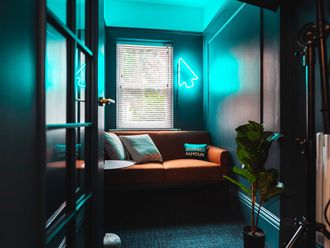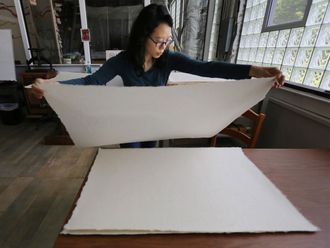
Open your kitchen cupboard and look at your tableware. Is it all white?
Of course not. There are a few pastel Tupperware boxes stacked in the corner, a couple of eccentric ceramics – cute coffee mugs – and, hey, my floral plates and bowls that are… hmm, mostly white . Guilty.
We’re so scared of colours that we’ve taken the minimalistic approach right down to the china we eat and drink in. (Though, the simplicity movement is quickly coming to an end, especially within homes for the past couple of years.)
Imagine sitting down with your morning tea in a glass cobalt blue cup. Imagine hearing the satisfying clink as you set down the cup on its matching translucent saucer. Truly a beacon of light in the dreary metaphorical climate of today.
American homes in the 1920s and ‘30s thought so, too. They had trinkets stashed in flamingo pink candy dishes, munched on biscuits from emerald green cookie jars and ate desserts in amber brown bowls. Years later, their rainbow collection was fondly referred to as Depression glass by hobbyists.
Once sold for pennies
Nothing depressing about the glass (in a sense), it’s just that these were in use around the time the stock market took a plunge and people lost their savings. Money was so scant during the Great Depression, starting in 1929 for a decade, that soup kitchens were a common sight in American streets.
“[Depression glass] pieces were sold in variety stores for pennies, so that homemakers could afford to add pieces to their sets,” writes Pam Meyer, president of the National Depression Glass Association in Kansas, in the foreword of ‘Warman’s Depression Glass: Identification and Price Guide’ by antique expert Ellen T. Schroy.
She continues: “These dishes were used everyday, brightening the otherwise drab lives of folks struggling through the Great Depression.”
Once valued at pennies, the coveted glassware is now worth hundreds of dollars on auction sites. A 1976 New York Times’ piece on Depression glass talks about how a 20-piece dinner set was sold for as little as $1.99, at time when 12.8 million Americans were out of jobs.
That’s picking up a glass dinnerware for Dh7 today, based on current rates.
First machine-made glass
What made them affordable? Their quick and cheap method of production. Major glass companies like Hazel-Atlas, Hocking and Jeannette Co. lucked out with the invention of the assembly line, the very same that allowed pioneer Henry Ford to manufacture one car under two hours. Costs fell substantially, even if thousands of glasses were being produced every day.
Depression glass was not painstakingly crafted by hand like its heavier and more expensive predecessors. The casual kitchenware became the first machine-made glass in American history. A mixture of sand, soda ash and limestone was molten then poured into a variety of patterned casts, all without the need for human blowers.
Pattern listings begin with Adam, characterised by square plates and bases, and end with honeycomb-patterned Yorktown. ‘Warman’s Depression Glass’ guide lists about 166 of them in alphabetical order.
What gave them their signature watery tint? A pinch of metal. Collectors’ favourite pink was made by adding a bit of selenium, while reds came from gold and blue from cobalt.
Buy one, get one bowl free
The glass was so cheap that struggling businesses would toss a cup, plate or a drinking glass into detergent and cereal boxes (even flour sacks!). And delighted housewives kept coming back for more colourful dinnerware freebies for the house.

Eventually movie theatres hopped on the trend and put up flyers for ‘Dish Nights’. In the 2007 book ‘Looking Past the Screen’ on American film history, professor Kathryn H. Fuller-Seeley discusses the promotional tactic in her chapter ‘Dish Night at the Movies’.
Whatever little spending was done back then, it was to put food on the table. Entertainment was a luxury for the thrifty American living during the Great Depression era, writes Fuller-Seeley. Women, who made up majority of moviegoers, were enticed with free glass pieces to dress the table with, as long as they bought tickets to screenings.
Where do I get Depression glass?
Bright, classy and sparkly, Depression glass is a vintage collector’s dream. It probably looks familiar because your grandparents poured you water from their staple pink glass pitcher.
A matching set, no matter which colour you’re eyeing, will give the kitchen that retro pop you’ve been looking for. A quick Google search will also tell you that reproduced Depression-like ware can be pricey. (Unless you’re willing to shell out hundreds for glass salt and pepper shakers.)
How do you get your hand on some without breaking bank? Online marketplaces like Etsy are a good starting point for snagging the best deal. A beautifully patterned amber teacup set can be bought for as little as Dh33. Another space to watch out for is social media platforms, where collectors routinely resell their finds under relevant hashtags.
Experts at National Depression Glass Association say that if you do plan on using the fragile tableware, as opposed to displaying, then wash manually. None of the pieces would survive the dishwasher!
(Note: This story was first published in August 2022)















